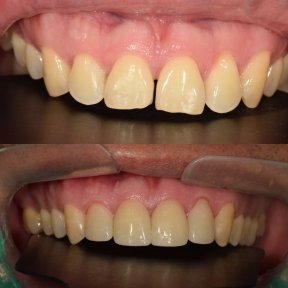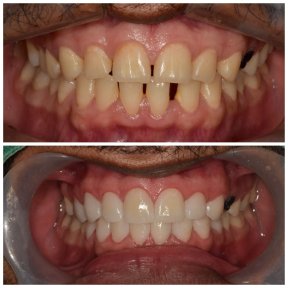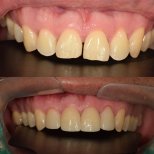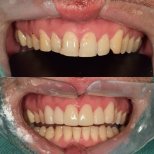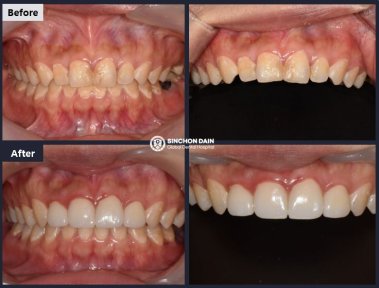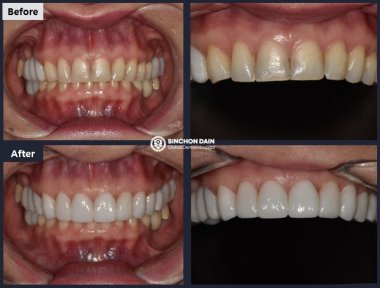- Technique: One-day veneers
- Kim Hyoeun Jeong is a board-certified specialist in conservative dentistry and director at Yonsei Uline Dental Clinic.
- Yonsei Uline Dental Clinic is led by a certified Invisalign provider and accredited member of the Korean Academy of Conservative Dentistry.
- Included services: Consultation with a dentist
- Stay info: Accommodation is not included; no hotel stay required.
What are Korean veneers?
Veneers are ultra-thin shells bonded to the front of the teeth to improve their shape, color, or alignment. What sets veneers in Korea apart is the focus on minimal tooth shaving and the use of digital design systems. This results in a natural appearance, strong bond, and faster treatment times compared to the US or Europe.
Who is a good candidate for veneers in Korea?
Dental veneers are suitable for adults who want to improve the appearance of their teeth and achieve a confident smile without major dental work. Ideal candidates include those who:
✔ Have generally good dental health and no active gum disease
✔ Have dental concerns like chipped, discolored, or slightly misaligned teeth
✔ Have enough tooth enamel for proper bonding
✔ Are not heavy teeth grinders (or are willing to use a night guard)
✔ Maintain good oral hygiene and attend regular check-ups
✔ Have realistic expectations about what cosmetic dental treatments can achieve
Patients may have previously treated teeth (e.g., with fillings), as long as the structure is stable. However, those with major structural damage, untreated decay, or severe bite issues may need other dental procedures first, such as crowns, orthodontic treatments, or root canal therapy.
Why get dental veneers in Korea?
South Korea is a global medical tourism hub. It attracts over 1.17 million international patients annually, including those who visit for cosmetic dentistry.
Here’s why patients choose Korea for veneer treatment:
➤ Advanced dental technology for precision and speed. Dental clinics use CAD/CAM systems and 3D imaging to design and place veneers with high accuracy. The technology allows them to complete the treatment in 1–3 days, compared to 1–2 weeks in the US or UK.
➤ 60%–70% cost savings. Veneers in Korea typically cost $400–$850 per tooth, compared to $1,400–$2,000 in the US or UK. Despite lower prices, the quality of materials and care is comparable.
➤ Top dental care system. A study published in the Journal of Dental Health, Oral Disorders & Therapy ranked South Korea 2nd for oral health system effectiveness, ahead of the USA, UK, Canada, and Australia.
➤ Minimal tooth alteration. Korean dentists emphasize minimal tooth shaving. It helps preserve more of the natural tooth structure, reduces sensitivity, and prevents long-term risks.
➤ Convenient for international patients. Dental clinics in Seoul and Busan offer English-speaking staff, pre-arrival consultations, airport transfers, and bundled treatment plans. There is an option of "one-day veneers," where the entire procedure—from consultation to fitting—can be completed in a single day.
➤ Regulated dental care. Dental hospitals are accredited by the Korean Ministry of Health and the Korean Institute for Healthcare Accreditation (KOIHA). This means cosmetic dentistry facilities meet strict national standards for hygiene, patient safety, staff qualifications, and quality of treatment.
What types of veneers are offered in Korea?
Korean dental clinics typically offer porcelain and composite veneers:
- Porcelain veneers are highly durable, stain-resistant, and offer a very natural appearance. They last 10–20 years with proper care.
- Composite veneers are made from composite resin, applied directly to the tooth surface and sculpted by the dentist. They’re more affordable but usually last 5–7 years and may stain over time.
Aside from the material, patients can choose from several veneer styles:
- Traditional veneers require moderate tooth reduction for proper fit and alignment. Often chosen when natural teeth are uneven, overlapping, or severely discolored.
- Laminate veneers are thin porcelain shells that require light tooth preparation for proper fit. Used for minor dental issues like stained teeth, small chips, or gaps.
- No-prep veneers are ultra-thin porcelain veneers that require no tooth shaving. Ideal for minor corrections. These preserve almost all of the natural tooth structure and are sometimes reversible.
The dentist selects the most appropriate veneer treatment based on the patient’s dental condition, cosmetic goals, and tooth enamel thickness.
What is the process of getting veneers in Korea?
In Korea, cosmetic dental procedures like veneers are designed to be fast and efficient, especially for international patients. In most cases, the entire process takes 1 to 3 days.
Here’s how it usually works:
1. Consultation and exam
The dentist evaluates your dental health, discusses your goals, and performs digital scans or X-rays.
2. Smile design
Using 3D imaging or CAD/CAM software, dentists digitally design your veneers to match your natural teeth in color, shape, and proportion.
3. Tooth preparation
If needed, a thin layer of enamel (around 0.3–0.7 mm) is removed to make space for the veneer. No-prep veneers often skip this step entirely.
4. Veneer fabrication
- If the clinic uses CAD/CAM systems, dentists can create custom veneers on-site in a few hours, enabling same-day or next-day placement.
- If the clinic relies on an external lab, fabrication may take 1–2 weeks. During this time, patients wear temporary veneers.
5. Bonding and placement
Once ready, veneers are fitted, adjusted, and permanently bonded. The dentist checks the bite and polishes the final result.
What should I expect after getting dental veneers?
| Timeline | What to expect |
| First 24–48 hours | Mild sensitivity to hot/cold; gums may feel slightly sore. |
|
First 1–3 days |
Avoid hard, sticky, or very hot/cold foods. |
| Up to 1 week | Veneers begin to feel natural; any discomfort should fade. |
| After 1 week | Normal eating and speaking resume fully; results settle in. |
Veneer aftercare tips
✔ Brush with a soft-bristled toothbrush and non-abrasive toothpaste.
✔ Floss gently around dental veneers to maintain gum health.
✔ Avoid using teeth to open packages or bite hard objects.
✔ Limit staining foods and drinks like coffee, red wine, and tobacco.
✔ Visit your dentist for regular cleanings and check-ups.
✔ Use a night guard if you grind your teeth during sleep.
Are Korean veneers permanent?
Porcelain veneers are a long-term but not permanent solution. Clinical studies show high survival rates over time:
- 96% at 10 years;
- 91% at 20 years.
What are the best dental clinics for veneers in Korea?
According to Bookimed’s ranking, these are the top clinics for veneers in Korea, selected for their expertise, technology, and patient-centered care:
1. Gangnam Gentle Dental Clinic
✔ Gangnam Gentle Dental Clinic offers ultra-thin, natural-looking veneers, 3D design, and tooth structure preservation.
✔ Led by Dr. Sungho Kim, a judge at the Miss Korea Global beauty pageant.
2. Sinchon Dain Dental Hospital
✔ Offers a one-day veneer program for international patients using in-house CEREC systems.
✔ Trusted by 16,000+ patients annually.
✔ Staffed with multilingual dentists trained at top US and Korean universities.
✔ Located near Incheon Airport—ideal for travelers.
✔ Accredited by KOIHA.
✔ Staffed by board-certified experts from Yonsei, NYU, and the University of the Pacific.
✔ Combines German E.max technology with holistic relaxation therapies.
✔ Offers on-site lab, 3D-CT, and stress-free care using aromatherapy and stone therapy.
What should I know before traveling to Korea for veneers?
| Category | Key information |
| Visa | Most Western tourists receive 90-day visa-free entry. Check your country's status on the Korean embassy website. |
| Travel | Flights from major US cities to Incheon take ~14 hours. Round-trip fares range from $440 to $630. |
| Accommodation cost | - Budget: $50–$100/night - Mid-range: $100–$200/night |
| Payment | Dental clinics accept KRW and credit cards (Visa, Mastercard). |
| Cultural Etiquette | - Bowing is a standard greeting. - Politeness is valued: say “annyeonghaseyo” (hello) and use both hands when receiving items. - Keep phone calls discreet and avoid eating on the subway. - Dress modestly when visiting clinics; casual but neat attire is appropriate. |
| Language | Dental clinics catering to medical tourists have English-speaking staff or offer interpreters. Basic translation apps are also useful. |
| Safety | Korea is one of the world’s 20 safest countries. Dial 119 for medical emergencies. Carry a note with your clinic’s contact info and hotel address. |
What are some alternatives to veneers in Korea?
If veneers aren’t the right fit for the patient, Korean dentists may recommend alternative treatments:
- Teeth whitening. Best for healthy teeth with surface stains or discolored teeth. Teeth whitening is fast, non-invasive, and cost-effective.
- Dental bonding. Composite resin is applied directly to the tooth to fix small chips, cracks, or gaps. Dental bonding is less expensive than veneers but less durable.
- Dental crowns. Used when natural teeth are heavily damaged, decayed, or heavily restored. Dental crowns cover the entire tooth and restore both function and appearance.
Resources
- Cleveland Clinic. (2022). Veneers.
- Ministry of Health and Welfare. (2025). Korea Attracts 1.17 Million Foreign Patients in 2024.
- Journal of Dental Health, Oral Disorders & Therapy. (2024). Comparison of the oral health status and costs of the provision of dental care in ten high-income countries.
- European Journal of Dentistry. (2020). Survival Rates for Porcelain Laminate Veneers: A Systematic Review.
